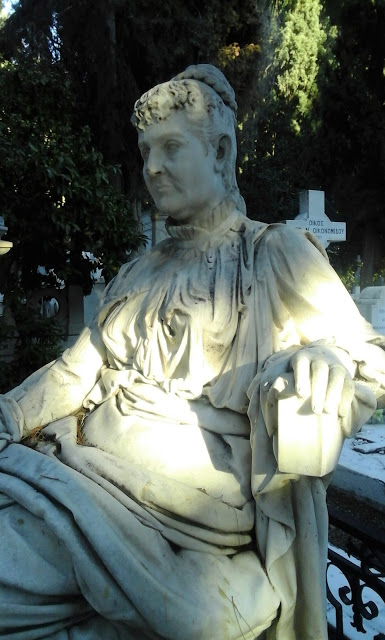The Ladies of The First
Cemetery
Among the monuments of the men: heroes,
politicians, movers and shakers, philosophers and writers, there are the
ladies – not as many, of course. The golden age of sculptural grave monuments
was the 19th and early 20th centuries – still pretty
much a man’s world - and women, the real women of that era, as opposed to
generic female figures such as angels or mourning spirits are less in
evidence than the men.
For that reason alone, we find ourselves
looking closely at the depiction of the women who are there, be they elegant,
idealistic, realistic, imposing, or just plain mysterious.
Here are just a few who have caught our eye:
This rather
unimposing bust of Kalliroi Parren
by sculptor Costas Valsamis is one of the first ladies you will encounter. It was
added to the Plaza in 1992 - 52 years after her death - in a better late than
never acknowledgement of her contribution to women’s rights. She was Greece’s
first feminist. Her actual grave is
tucked inconspicuously away in Section 4, Number 221.
The “wife
of Mr Konstamouli” by Ioannis Lampaditis (1856-1920) reflects a
severe style popular at that time:
A closer look at our ladies often reveals an
exquisite detail such as the arresting
glance of the writer Charisis Pouliou (Χαρίσης Πουλίου).
Section 5,
Number 219
The writing below the bust of Maria Triandafillou
may have completely worn away, but her intricate curls
have managed to stand the test of time.
Then there is the lady seated on the imposing 1930’s
tomb of businessman Othon Tetenes:
Section 8,
Number 128
A mature work of sculptor
Thomas Thomopoulos, this monument invites
you to clamor up for a closer look.
Sleeping Ladies
Sleeping ladies are a genre
all by themselves. There are six in the First–all but one are apparently true
likenesses and most are in the traditional, romantic mold. But the one (1926)
on the tomb of the Tsevas family by sculptor Evangelos Vrettos is startling:
Section 5,
Number 219
Rather than resting in peace, she looks wide
awake and ready for action….
Generic Ladies
Classical figures are no surprise if you have
read our section on Ancient Greece in the
Cemetery. There are two lovely examples on the walkway leading to Agios
Lazarus Church.
Ioannis Vitsaris’ symbol of justice:
and
Georgios Vroutsos’ symbol of Science:
The Mourning Figure
One of the most prevalent ladies in the
cemetery is the Mourning Figure, whether
angel or not. Her portrayal is the
most varied and has undergone the greatest transition over time although one should never underestimate the tendency to return to earlier models in the First Cemetery. Therefore dating a work is not always easy.
This one on the Andropoulos tomb is by
sculptor Iakovos Malakates, one of the first sculptors in the First cemetery:
Section 2,
Number 122,
On the Mandelas family grave, above, all of
the mourning ladies wear headscarves, a custom that lasted until well after
the Second world war in much of Greece. (sculptor Klearchos Loukopoulos):
Section
14, Number 145
A beautiful bas relief in Section 14 called
in Greek "Ω ΔΕΣΠΟΙΝΑ ΜΟΥ" translates into something like “my honoured lady” and has no
other name. It is by sculptor
Praxitelis Tzanoulinos:
Each lady in the First, idealized or real (and we
have only scratched the surface), is well worth a closer look as you get to know the cemetery better.
|
||||||||||||||||||||||||||||||||||||||||
Footnote
(1)
In fact
both figures on this monument were modeled on much earlier portraits which explains the old
fashioned look. Or perhaps the family simply preferred that style.
|
||||||||||||||||||||||||||||||||||||||||
Πέμπτη 29 Ιουνίου 2017
The Ladies
Εγγραφή σε:
Σχόλια ανάρτησης (Atom)




























Αυτό το σχόλιο αφαιρέθηκε από έναν διαχειριστή ιστολογίου.
ΑπάντησηΔιαγραφή